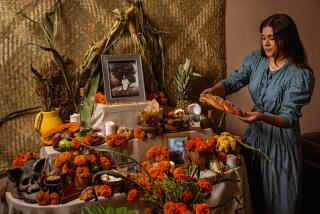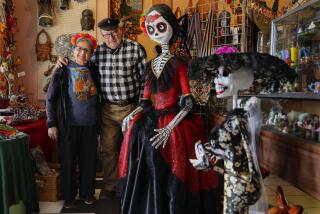The Gold-Filled Life of a Warrior-Priest : Antiquities: A display of funerary items at UCLA offers a look at the opulence surrounding the pre-Inca Moche civilization in Sipan, Peru.
- Share via
SIPAN, Peru — In this lush, sugar cane-growing northern river valley near to both coast and desert, the land suddenly adopts an almost lunar aspect. To an untrained eye, it seems as if bomber pilots have run amok, tearing the turf asunder.
There, though, in the midst of the extensive digging, stands an eroded mud brick platform. It’s not much to see.
But the structure, the archeological excavations surrounding it and the pyramids that rise nearby, hint of astonishing ancient happenings here, mythic spectacles that had once been captured only on murals and painted pottery extracted from this area.
The lore told of a chilling rite in which unclothed prisoners, some borne on litters, had been marched in a procession toward bejeweled princes and priests.
Before the captives had traveled far, though, attendants appeared. They slit the prisoners’ throats and presented their blood in dripping goblets to one figure adorned in shimmering silver and burnished gold.
He came to be known simply as the Warrior-Priest of Sipan.
But who was this powerful individual? Did he actually exist? And how did he acquire such sway in his society? How did he exercise it? How did he live and die?
Many of the Warrior-Priest’s secrets are being divulged in “Royal Tombs of Sipan”--a dazzling display of funerary offerings, some of the most opulent ever scientifically excavated in the Americas--currently at UCLA’s Fowler Museum of Cultural History.
The 200 or so objects from Sipan, and other works of Moche art, many of them restored as part of a $1-million conservation program at the Roemisch-Germanisches Museum in Mainz, Germany, will cross America for two years, with stops in Houston, New York, Detroit and Washington.
In 1995, the treasures--including masks, armor and jewelry--then will return to the nearby Lambayeque’s Bruening Museum. The $800,000 in anticipated proceeds from the tour will help build a new wing to house the objects.
“The lords of Sipan will construct their own new home,” said Walter Alva, who is the Bruening’s director and Sipan’s excavator.
The Sipan exhibit, replete with its own bizarre, recent overlay of crime, violence and bloodshed, offers a detailed look at some of the continuing labors of Peruvian archeologists, who, five years ago, discovered the first of three gold-filled tombs of a 1,700-year-old mausoleum of the pre-Inca Moche civilization.
From AD 100 to 800, the Moche controlled a swath of desert and river valleys stretching some 250 miles along Peru’s northern coast. They built their villages, temples and palaces in river valleys replete with sophisticated irrigation systems.
Unlike the Maya, their Mexican contemporaries, the Moche had no written language; only a vivid artistic record and careful excavation has allowed experts to begin to reconstruct the story of their civilization.
The wealth of valuable information from Sipan has redefined archeologists’ understanding of Moche social organization, ceremony, religion, art and technology.
“Sipan has opened new perspectives for Peru’s ancient Moche,” Alva said.
Based on information derived from excavations here and elsewhere in the Moche heartland, archeologists have modified their theories, which held that this kingdom was controlled from the city of Trujillo, some 100 miles south of Sipan.
Instead, Christopher Donnan, the Fowler’s director and a UCLA anthropology professor who co-curated the “Royal Tombs,” believes that each river valley housed a separate principality or court that followed the conventions of Moche society, religion and art.
Like European royalty, the Moche ruling class was related, but its members ruled independently. Unlike the royal families of Europe, the descendants of the Moche elite did not inherit wealth; their treasures, instead, accompanied Moche lords to the afterlife.
Sipan may have been a court seat, and the burial platform here served from AD 100-300 as a mausoleum for a succession of Moche lords and priests who took part in a ritual known as the Sacrifice Ceremony, Donnan said.
The ceremony had been seen as a recurring theme in Moche murals and painted pottery, he explained. But for a long time, experts were perplexed as to whether the ritual was real or imagined. The Moche funerary offerings, unearthed by archeologists at Sipan, indicate that the human sacrifices did occur and were not merely artistic visions.
The evidence suggests that Sipan’s Warrior-Priest, who lived around AD 300, was the central figure in the complex sacrifice ritual.
“Prior to these excavations we had never seen such a perfect match between objects found in Moche tombs and objects shown being worn and used ceremoniously in Moche art,” Donnan wrote recently.
The Warrior-Priest’s tomb was the most elaborate of all uncovered, so far. He lay in a wooden plank coffin held together by copper strapping. Sipan’s other lavish burials, Donnan theorizes, were those of lesser priests and attendants who also participated in the Sacrifice Ceremony. Ritual caches that included human hands and feet may be remains of sacrifice ceremony victims.
Sipan’s skilled metal smiths produced hundreds of hammered and cast gold, silver, copper, silvered and gilded copper necklaces, head dresses, ear spools, nose ornaments and weapons that accompanied Sipan’s lords to their graves. They also perfected techniques that could produce a golden surface on objects containing little gold.
One nose ornament, found in a lord’s tomb and to be exhibited, depicts a miniature gold warrior mounted on a silver plate. He wears turquoise armor and a gold nose ornament and holds a shield and a club. The outspread wings of an owl perched on the warrior’s head form his headdress.
Archeologists believe that around AD 800 El Nino rains, floods and famine wiped out the Moche. Although their descendants continued to produce works of art in metal and pottery, they never attained the creativity and technical mastery of their forebears.
But because the Moche created some of ancient Peru’s most stunning works of art, their legacy has helped spur the plunder of their temples and tombs.
Indeed, a trail of intrigue and plundered gold and silver treasure led to the Sipan site in 1987 after police got wind of clandestine looting here and Moche metalwork began to flood the antiquities markets in Lima and internationally.
Although looting is illegal in Peru, this country’s ravaged economy, its confusing laws on ancient sites and the lax enforcement of the measures that do exist, do little to stop the plunder.
Villagers still claim Sipan’s real discoverer is Ernil Bernal, a looter who was killed by police when they raided his home.
Juan, a friend who asked not to be fully identified, said Bernal made $300,000 on his first sale of Sipan loot. “My hands were shaking. I’d never seen so much money,” said Juan, who witnessed the sale.
Showing a visitor around the recently dug-up ancient cemetery of Pacherrez a few miles up the valley from Sipan, Juan pointed to scattered fragments of pottery and bits of human bone tinged green, indicating that the sites where they had been buried also contained copper objects.
Alva said looting is fueled by a lively domestic market, as well as by the international antiquities trade. The crime, however, not only leads to objects being stripped of invaluable scientific information but also robs poor countries rich in art of their cultural heritage.
Over the centuries, the destruction of Peru’s ancient sites has been so relentless that few archeologists believed any royal tombs had survived--until the discoveries at Sipan.
Clues from on-going excavations at Sipan hint that the burial platform may yield more opulent burials. “There’s always the possibility,” Alva said.
But, for now, he said, the reminders he has of the glory of Sipan lie in silent objects, such as the striking loot seized by police from the Bernal home: a gold human head with eyes of silver and lapis lazuli and a gold feline head with fangs of inlaid shell.
* The exhibit is open daily from noon to 5 p.m. and on Mondays and Thursdays until 8 p.m. at the Fowler, 405 Hilgard Ave. Admission is free on Mondays from 5 p.m. to 8 p.m., but otherwise is $5. Children younger than 5 admitted free.
More to Read
Sign up for Essential California
The most important California stories and recommendations in your inbox every morning.
You may occasionally receive promotional content from the Los Angeles Times.










